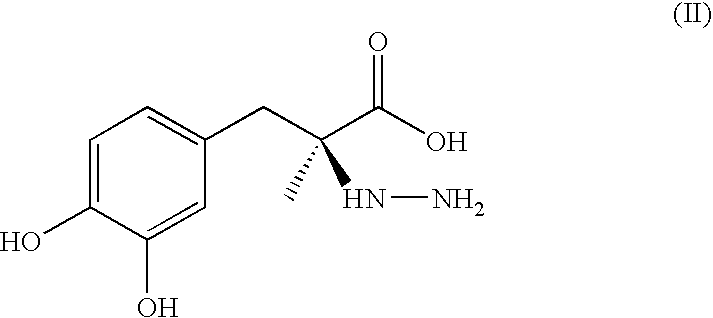Sustained-release composition and method of use thereof
a technology of suspension release and composition, which is applied in the direction of drug compositions, peptide/protein ingredients, biocides, etc., can solve the problems of ratchety, impaired balance, and ratchety, and achieve the effect of reducing or minimizing motor complications
- Summary
- Abstract
- Description
- Claims
- Application Information
AI Technical Summary
Benefits of technology
Problems solved by technology
Method used
Image
Examples
example 1
[0162]Tablet formulations A and B are prepared comprising ingredients in ranges of amounts as shown in Table 1.
TABLE 1Compositions of tablet formulations A and B (weights in mg)IngredientAB 1. levodopa150-300 150-300 2. carbidopa40-80 40-80 3. silicon dioxide 1-2.5 1-2.5 4. high-viscosity hypromellose, e.g.,25-1000 Methocel ™ K100M 5. low-viscosity hypromellose, e.g.,20-50 20-50 Methocel ™ E3LV 6. high-viscosity HPC, e.g., Klucel ™ HHX25-100 7. sodium alginate LFR 5 / 60200-400 200-400 8. calcium carbonate USP, heavy25-10025-100 9. sodium lauryl sulfate 1-2.5 1-2.510. organic acid*5-205-2011. stearic acid, purified5-105-1012. magnesium stearate2.5-5 2.5-5 Total weight500-1000500-1000*total of one or more of citric, fumaric, malic, glutamic, succinic and tartaric acids
[0163]If included, high-viscosity hypromellose (item 4) is prepared as a 10% solution in water. Items 1-8 are charged to a suitable twin-shell blender and blended for about 10 minutes. The resulting blend is cha...
example 2
[0164]Tablet formulations A and B prepared as above are subjected to dissolution testing for both levodopa and carbidopa (USP apparatus II with paddles, 50 rpm, dissolution medium 900 ml 0.1N HCl) over a 12 hour period. Results for both formulations are typically in the ranges shown in Table 2.
TABLE 2Dissolution of tablet formulationsIngredientTime (h)% Dissolvedlevodopa115-25225-40440-70865-801280-95carbidopa115-25225-40440-70865-801280-95
PUM
| Property | Measurement | Unit |
|---|---|---|
| concentration | aaaaa | aaaaa |
| threshold concentration | aaaaa | aaaaa |
| concentration | aaaaa | aaaaa |
Abstract
Description
Claims
Application Information
 Login to View More
Login to View More - R&D
- Intellectual Property
- Life Sciences
- Materials
- Tech Scout
- Unparalleled Data Quality
- Higher Quality Content
- 60% Fewer Hallucinations
Browse by: Latest US Patents, China's latest patents, Technical Efficacy Thesaurus, Application Domain, Technology Topic, Popular Technical Reports.
© 2025 PatSnap. All rights reserved.Legal|Privacy policy|Modern Slavery Act Transparency Statement|Sitemap|About US| Contact US: help@patsnap.com


